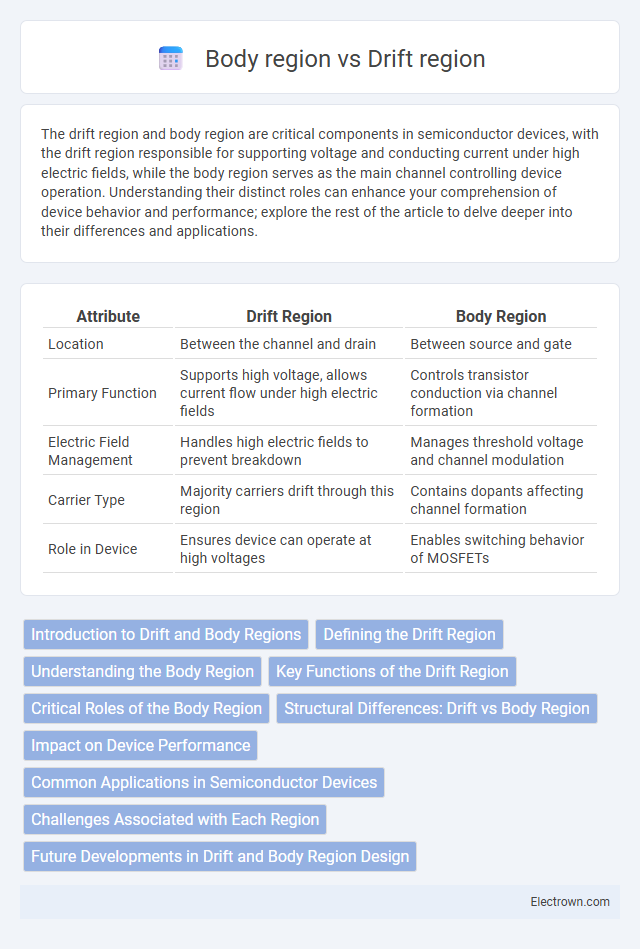The drift region and body region are critical components in semiconductor devices, with the drift region responsible for supporting voltage and conducting current under high electric fields, while the body region serves as the main channel controlling device operation. Understanding their distinct roles can enhance your comprehension of device behavior and performance; explore the rest of the article to delve deeper into their differences and applications.
Table of Comparison
| Attribute | Drift Region | Body Region |
|---|---|---|
| Location | Between the channel and drain | Between source and gate |
| Primary Function | Supports high voltage, allows current flow under high electric fields | Controls transistor conduction via channel formation |
| Electric Field Management | Handles high electric fields to prevent breakdown | Manages threshold voltage and channel modulation |
| Carrier Type | Majority carriers drift through this region | Contains dopants affecting channel formation |
| Role in Device | Ensures device can operate at high voltages | Enables switching behavior of MOSFETs |
Introduction to Drift and Body Regions
The Drift region in a semiconductor device is a lightly doped area that supports the voltage drop during high-voltage operation, enabling efficient current flow and reduced power loss. The Body region, typically heavily doped, acts as the substrate or base, controlling the device's threshold voltage and channel formation. Understanding the interaction between your device's Drift and Body regions is crucial for optimizing electrical performance and reliability in power electronics.
Defining the Drift Region
The Drift Region in a semiconductor device is a lightly doped area designed to support high voltage by spreading the electric field, enabling efficient current flow without breakdown. This region contrasts with the Body Region, which is typically more heavily doped and serves as the channel control area in devices like MOSFETs. Understanding the Drift Region's role is crucial for optimizing your device's voltage handling and on-resistance performance.
Understanding the Body Region
The Body Region in semiconductor devices acts as a crucial control element by influencing the threshold voltage and channel formation in transistors. Unlike the Drift Region, which primarily manages high-voltage tolerance and current flow through extended depletion areas, the Body Region directly impacts device switching behavior and leakage currents. Understanding Your device's Body Region helps optimize performance and reliability in integrated circuits.
Key Functions of the Drift Region
The drift region in power semiconductor devices primarily manages high voltage blocking and distributes the electric field uniformly to prevent device breakdown, ensuring reliable operation under high voltage stress. Unlike the body region, which controls channel formation and conduction, the drift region supports current flow during the on-state by providing a low-resistance path. Your device's performance and efficiency under high voltage conditions heavily depend on the optimized design of the drift region.
Critical Roles of the Body Region
The body region in semiconductor devices plays a critical role in controlling the threshold voltage and channel formation, directly impacting device switching characteristics and leakage currents. Unlike the drift region, which primarily manages high voltage blocking and current flow, the body region influences the device's immunity to short-channel effects and determines the device's overall reliability and performance. Optimizing the body region doping and structure enhances device scalability and ensures stable operation under various electrical stresses.
Structural Differences: Drift vs Body Region
The Drift region in semiconductor devices is characterized by a lightly doped, extended area designed to support high voltage and reduce electric field intensity, often found in power MOSFETs. The Body region, in contrast, is a more heavily doped area beneath the gate, providing the channel where current flow is controlled. Understanding the structural differences between the Drift and Body regions helps optimize device performance, such as balancing on-resistance and breakdown voltage in your semiconductor design.
Impact on Device Performance
The drift region influences the device's breakdown voltage and ON-resistance, with a longer drift region improving voltage tolerance but increasing resistance, thus impacting switching speed and power efficiency. The body region controls threshold voltage and leakage currents, directly affecting device stability and switching characteristics. Optimizing the balance between drift and body regions enhances your device's overall performance by improving efficiency, reliability, and thermal management.
Common Applications in Semiconductor Devices
The drift region in semiconductor devices is primarily utilized in high-voltage applications such as power MOSFETs and IGBTs, where it enables efficient current conduction and withstands large voltage drops. The body region, typically found in MOSFETs, plays a crucial role in controlling the threshold voltage and preventing parasitic conduction by forming the channel region during device operation. These distinct regions optimize device performance: the drift region enhances voltage handling capability while the body region ensures precise switching and reduces leakage currents.
Challenges Associated with Each Region
The Drift region faces challenges such as increased resistance and higher on-state voltage drop, which directly impact device efficiency and power handling capability. The Body region struggles with controlling the threshold voltage and minimizing leakage current, essential for maintaining device stability and reducing power loss. Both regions require careful optimization to balance trade-offs between performance, reliability, and manufacturing complexity in semiconductor devices.
Future Developments in Drift and Body Region Design
Future developments in drift region design focus on reducing on-resistance and enhancing breakdown voltage through advanced materials like SiC and GaN, improving device reliability and efficiency. Body region innovations target minimizing leakage current and short-channel effects by optimizing doping profiles and introducing new gate-controlled structures, enhancing overall device performance. Your power devices will benefit from these breakthroughs, enabling faster switching speeds and greater thermal stability in next-generation applications.
Drift region vs Body region Infographic

 electrown.com
electrown.com